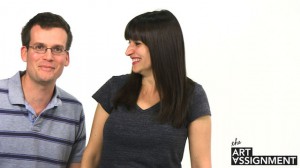PBS Digital Studios has teamed up with Sarah Green, formerly a Curator of Contemporary Art at the Indianapolis Museum of Art, and YouTuber and New York Times best-selling author John Green to bring a whole new kind of channel to YouTube. The Art Assignment is a new web series that introduces us to U.S. artists, emerging and established, and asks each artist to give the audience an assignment. The show does two things really well: It exposes YouTube’s vast demographic to artists and art spaces they might not otherwise know and gets people making art.
It has only been in recent years that channels have arisen which fully take advantage of online video interactivity. For everything from transmedia sitcoms like My Music, response video talk shows like Pogobat, and even collaborative storytelling efforts like The Good Stuff. But The Art Assignment promises to utilize this interactivity not just for fan interaction but to bring those traditional “learn by doing” art teaching techniques to the Internet. The show leverages and celebrates the vibrant creative culture already rampant online, but also helps demystify and re-popularise capital-A contemporary art.

The Art Assignment hosts Sarah Green and John Green
The first episode features Flux Factory, a non-profit arts organization focused on fostering collaboration in Long Island City, Queens. Christopher Robbins, self described as a maker of “socially mediated public art,” and Douglas Paulson, also a social practice artist, kick off The Art Assignment with a replay of their first meeting. At the time the pair were both living in Europe and decided to meet in the exact geographical halfway point between their two locations. The assignment asked viewers to do the same: choose a friend, determine the halfway point between your two locations, decide on a time and meet in the middle with no further communication.
So not only is the show an exciting addition to the sparse community of videos about art online but The Art Assignment also illustrates a fundamental hurdle to creating well produced shows on YouTube. Not long after the trailer was launched in September of last year, YouTube killed its video response feature, which allowed reply videos to link to an original post to facilitate online conversation. And, since the core functionality of the show is to elicit documented art making, that change in functionality affects how people can interact.


